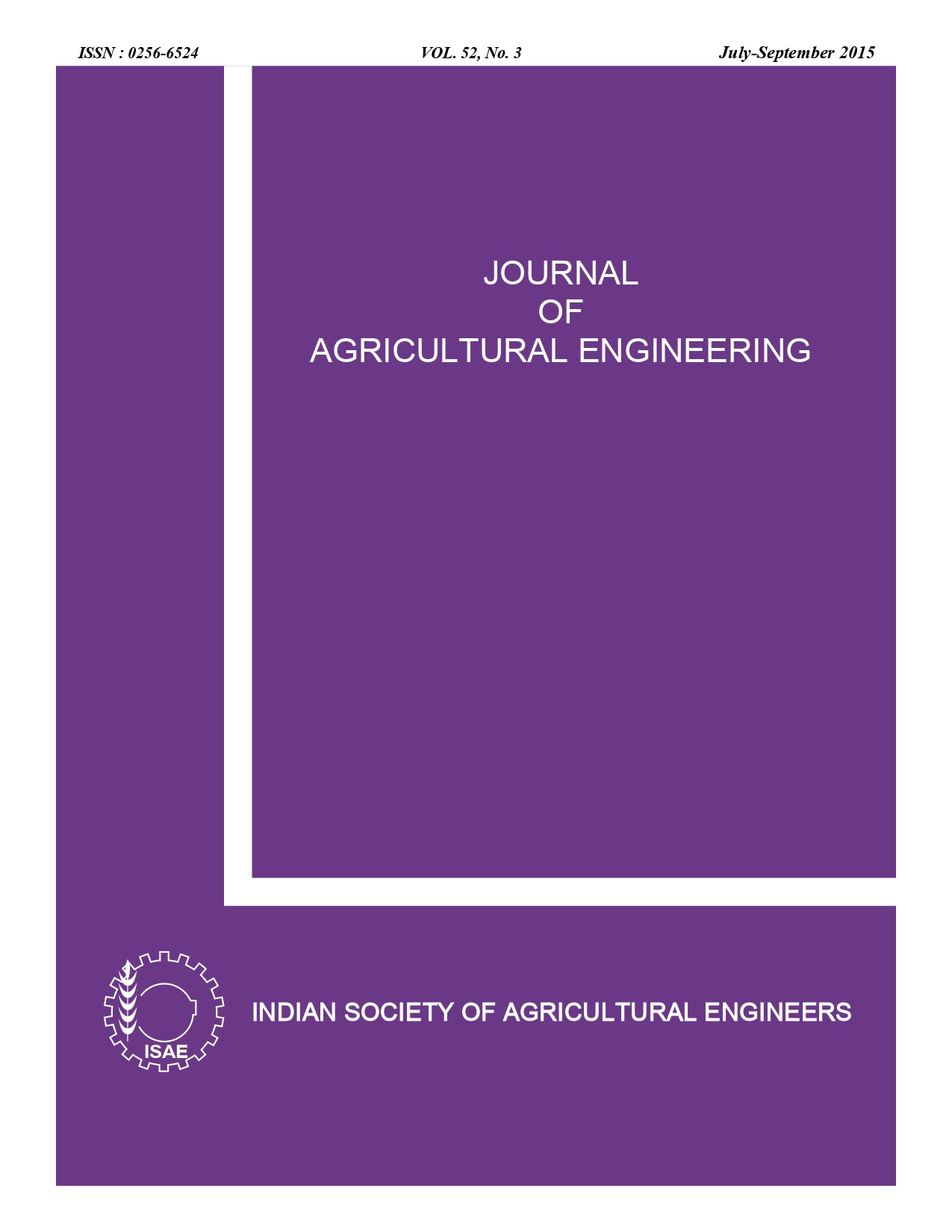Removal of Lead from Sewage Water using Response Surface Methodology: A Case Study
DOI:
https://doi.org/10.52151/jae2015523.1581Keywords:
Response surface methodology, Box-Behnken experimental design, sewage water, optimizationAbstract
Removal of lead (Pb) from sewage water by phytorid sewage treatment plant was studied at Agriculture College, Maharajbag, Nagpur to examine the efficacy of the phytorid sewage treatment plant in Pb removal from the sewage water, and to determine the optimum condition using response surface methodology. A Box-Behnken model was employed as an experimental design. The effect of three independent variables hydraulic loading or flow (50 - 150 m3 .d-1), dilution (10 - 80 %) and spatial length (16 - 100 %) was studied on Pb removal from the sewage water in bench mode of the experiment. The optimal conditions of Pb removal were found to be flow of 86 m3 .d-1, dilution of 78% and spatial length of 55 per cent. Under these experimental conditions, the experimental Pb removal obtained was 0.0035 mg.l-1. The proposed model equation using the RSM showed good agreement with the experimental data, with a coefficient of determination (R2 ) of 98.30 per cent. The result showed that optimised condition could be used for the efficient removal of the Pb from the sewage water.
References
Ahmad A L; Ismail S; Bhatia S. 2005. Optimization of coagulation flocculation process for palm oil mill effluent using response surface modelling. J. Environ. Sci. Technol., 39, 2828-2834.
Anon. 2005. Phytorid technology: A natural technique for municipal and industrial waste water treatment. International patented technology, Technical folder, National Environmental Engineering Research Institute, Nagpur.
Arulkumar M; Sathishkumar P; Palvannan T. 2011. Optimization of orange G dye adsorption by activated carbon of (Thespesiapopulnea) podsusing response surface methodology, J. Hazard. Mater., 186, 827–834.
Aslan N; Cebeci Y. 2007. Application of Box–Behnken design and response surface methodology for modeling of some Turkish coals. Fuel J., 86, 90-97.
Bhanarkar A D; Gupta R K; Biniwale R B; Tamhane S M. 2011. Nitric oxide absorption by hydrogen peroxide in airlift reactor: A case study using response surface methodology. Int. J. Environ. Sci. Technol., DOI 10.1007s13762-013-0295-z
Can M Y; Kaya Y; Algur. 2006. Response surface optimization of the removal of nickel from aqueous solution by cone biomass of Pinussylvestris. Bioresour. Technol.,97, 1761–1765.
Jamwal Priyanka; Mittal A K. 2010. Reuse of treated sewage water in Delhi city: Microbial evaluation of STPs and reuse options. Resour. Conserv. Recycling, 54, 211-221.
Khajeh M. 2011. Optimization of process variables for essential oil components from Satureja hortensis by supercritical fluid extraction using Box-Behnken experimental design. J. Supercrit Fluids, 55, 944–948.
Kincl M; Turk S; Vrecer F. 2005.Application of experimental design methodology in development and optimization of drug release method. Int. J. Pharm., 291, 39–49.
Korbhati B K; Rouf M A. 2008. Application of response surface analysis to the photolytic degradation of Basic Red 2 dye.Chem. Eng. J., 138,166-171.
Liu H L; LanY W; Cheng Y C. 2004. Optimal production of sulphuric acid by Thiobacillusthiooxidans using response surface methodology. Process Biochem., 39, 1953–1961.
Massoud M A; Tarhini A; Nasar J A. 2009. Decentralized approaches to wastewater treatment and management: applicability in developing countries. Environ. Manage., 90, 652–659.
Meng H; X Hu; Neville A. 2007. A systematic erosion corrosion study of two stainless steels in marine conditions via experimental design. Wear, 263, 355–362.
Moghaddam S S; Moghaddam M R A; Arami M. 2011. Response surface optimization of acid red 119 dye from simulated wastewater using Al based waterworks sludge and poly aluminium chloride as coagulant. J. Environ. Manage., 92, 1284-1291.
Myers R H; Montgomery D C. 2002. Response Surface Methodology: Process and Product Optimization Using Designed Experiments. Second ed., John Wiley & Sons, New York.
Sen R; Swaminathan T. 2004. Response surface modelling and optimization to elucidate and analyze the effects of inoculum age and size on surfactin production. Biochem. Eng. J., 21, 141–148.
Singh K P; Gupta S; Singh A K; Sinha S. 2011.Optimizing adsorption of crystal violet dye from water by magnetic nano composite using response surface modeling approach. J. Hazard. Mater., 186 (2-3), 1462 -1473.
Yetilmezsoy Kaan; Sevgi Demirel; Robert J Vanderbei. 2009. Response surface modeling of Pb (II) removal from aqueous solution by Pistaciavera L.: Box Behnken experimental design. J. Hazard. Mater., 171,551-562.
Zhang Zhengyong; Peng Jinhui; Srinivasakannan C; Zhang Zebiao; Zhang Libo; Fernándezd Y; Menendezd J A. 2010. Leaching zinc from spent catalyst: Process optimization using response surface methodology. J. Hazard. Mater., 176, 1113–1117.














